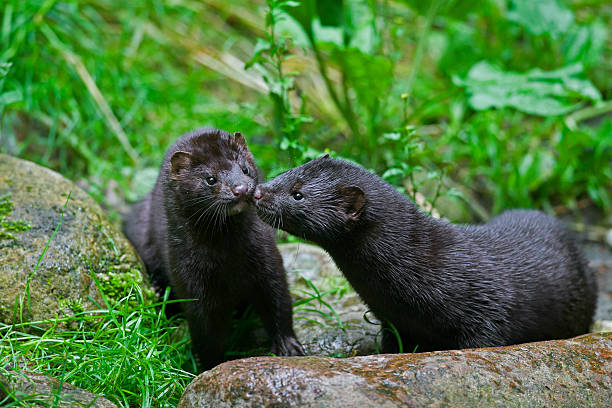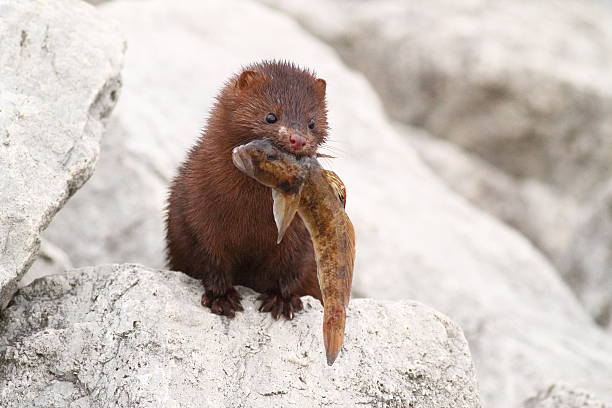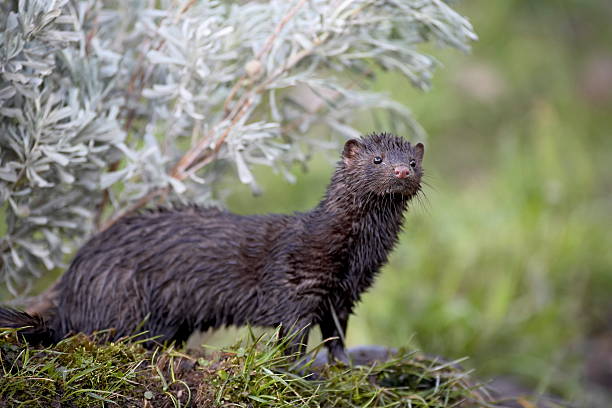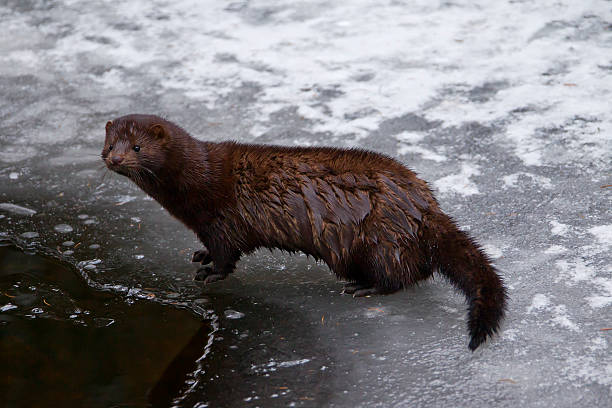Table of Contents
Scientific Classification
| Kingdom | Animalia |
| Phylum | Chordata |
| Class | Mammalia |
| Order | Carnivora |
| Family | Mustelidae |
| Genus | Neovison |
| Species | Neovison vison |
| Scientific Name | Neovison vison |
Description
The American mink (Neovison vison) is a carnivorous mammal that thrives near water. It features a sleek body, shiny fur, and agile movements. With a long, slender shape, bushy tail, short legs, and webbed feet, it excels at swimming. Minks usually sport dark brown fur, occasionally adorned with a white patch on their chin or chest. Their luxurious fur is highly sought after in the fashion industry, resulting in extensive breeding on fur farms.
Minks are classified as small to medium-sized carnivores, measuring between 18 to 27 inches (46 to 68 cm) in length, including their tail. They typically weigh between 1.5 to 3.5 pounds (0.7 to 1.6 kg), with males being noticeably larger than females.

Distribution
The American mink is originally from North America, with its habitat stretching from Canada and Alaska all the way to the southeastern United States. It has also made its way to regions in Europe, South America, and Asia. This expansion often raises ecological concerns due to its impact on native species.
Habitat
Minks live in many places, but they are usually found near freshwater. This includes rivers, lakes, marshes, and streams. They like spots with thick plants by the banks. This gives them cover for hunting and nesting. They also adapt well to coastal environments and wetlands.
Diet
Minks are opportunistic carnivores with a varied diet that consists of:
- Fish
- Frogs and amphibians
- Crustaceans (like crayfish)
- Small mammals (such as rabbits and rodents)
- Birds and their eggs
- Insects
These skilled hunters often stash away surplus food in their dens for later use.

Behavior
Minks are solitary and territorial creatures, using scent glands to mark their territories. While they are primarily nocturnal, they can also be spotted during the day, particularly in tranquil areas.
These animals are skilled swimmers and climbers, leveraging their agility to hunt both on land and in water. Minks typically construct burrows near water sources, often utilizing abandoned dens from other animals or creating their own.
Lifespan
In the wild, American minks typically have a lifespan of around 3 to 4 years. This shorter duration is largely due to threats from predators and various environmental challenges. In contrast, when kept in captivity and given appropriate care, they can live for as long as 10 years.
Reproduction and Lifecycle
The breeding season occurs between late winter and early spring (February to April). Minks have delayed implantation. This means fertilized eggs may not develop right away. This helps ensure the best time for giving birth.
Gestation Period: Approximately 40-75 days
Litter Size: Typically 4-6 kits
Weaning: At around 6-8 weeks
Sexual Maturity: Reached at about 10-12 months
Mink mothers are highly protective, raising their young alone in secure dens. Kits learn to hunt by the time they are three months old and become independent by autumn.

Predators
Minks face predation from larger carnivores, including:
Coyotes
Bobcats
Foxes
Birds of prey (hawks, owls, eagles)
Humans are important predators. They hunt minks for their fur or to control their population.
Adaptations
American minks have developed several adaptations that aid in their survival:
Waterproof Fur: Their dense, oily fur repels water, ensuring they stay warm and dry.
Webbed Feet: This feature improves their swimming skills.
Sharp Teeth and Claws: These are essential for catching and subduing prey.
Scent Marking: Minks use this method for communication and to defend their territory.
Keen Senses: Their excellent vision, hearing, and sense of smell are crucial for hunting and avoiding predators.
Conservation Status
The IUCN categorizes the American mink as a species of Least Concern due to its large population and adaptability to various environments. However, in certain regions, they are threatened by habitat destruction and pollution. Additionally, the mink fur industry raises concerns regarding their welfare in captivity.
In areas where minks have been introduced, they are considered invasive, negatively impacting local wildlife. Conservation efforts aim to manage these invasive species while also protecting wild minks in their natural habitats.
Conclusion
The American mink is a remarkable and versatile species. It flourishes in various ecosystems across North America. Its ability to adapt, sharp hunting instincts, and semi-aquatic lifestyle make it an intriguing animal. Conservation efforts are essential to ensure a balance between human activities and the well-being of mink populations. While they are not currently endangered, proactive measures are necessary. Understanding their role in ecosystems highlights the importance of safeguarding their natural habitats and aids in managing their presence in areas where they are not native.



